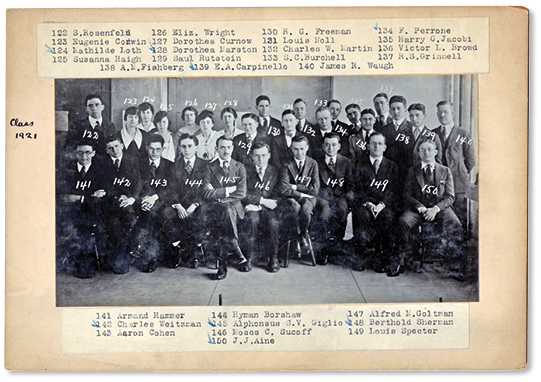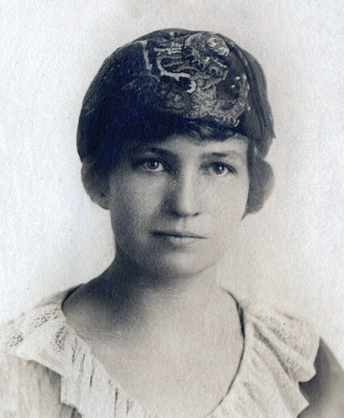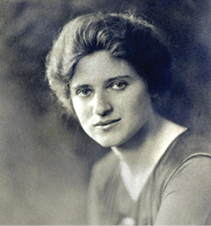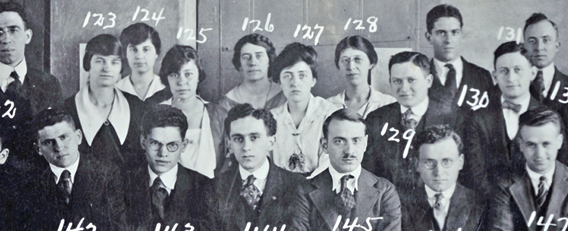Gentle Persistence
Up until 1917, Columbia University’s College of Physicians and Surgeons—by then 150 years old—had admitted no women.
At the turn of the 20th century, P&S, as it was known then, was already lagging behind its peers in coeducation. The University of Michigan medical school was the first in the United States to open its doors to women, welcoming its first female student in 1870. Michigan was soon followed by Johns Hopkins (1893) and Cornell (1898). By 1904, 97 of 160 U.S. medical schools were coeducational. That percentage grew over the next decade.
 Photo of the Class of 1921
Photo of the Class of 1921Columbia may have been content to continue with its all-male medical school for decades, if not for an ambitious young woman who set her mind to changing the tradition.
 Gulli Lindh
Gulli LindhGulli Lindh, a Barnard College senior, was fast approaching graduation in the spring of 1917. She had always dreamed of being a doctor, so she began a letter-writing campaign to apply to P&S. Her cause soon found a formidable ally in Barnard Dean Virginia Gildersleeve, PhD, whose 36-year tenure as dean made way for significant advancements in educational opportunities for female students.
And as much as Dr. Gildersleeve proved the perfect ally, Lindh proved the ideal candidate for breaking the glass ceiling at P&S. In her memoirs, Dr. Gildersleeve wrote of Lindh: “I had the perfect candidate for admission, a charming, sensible, and brilliantly able young Swedish woman.”
In promoting Ms. Lindh’s request to attend P&S, Dr. Gildersleeve called on P&S Dean Samuel Lambert, MD, who was stubbornly obstinate in his refusal. Dr. Lambert immediately offered a litany of reasons that young women shouldn’t join his student body. For one, there were no suitable restrooms or locker rooms for women; the existing facilities would have to be completely overhauled to accommodate them.
Ms. Lindh and Dr. Gildersleeve were undeterred, keeping up their gentle but persistent campaign over the course of several meetings. Soon, their tenacity resulted in a challenge. Dr. Lambert called on the Barnard women to raise $50,000 (approximately 1 million in today’s dollars) for overhauled facilities to accommodate female students. If they could fund the necessary renovations before the school year began—only months away—he would consider admitting Ms. Lindh and other female applicants.
Ms. Lindh and Dr. Gildersleeve set to work immediately. Ms. Lindh raised a few hundred dollars, and Dr. Gildersleeve called on friends and colleagues to raise a few thousand. They were far short of the $50,000 Dr. Lambert had demanded. Ms. Lindh had already accepted a spot at Johns Hopkins when she visited Dr. Lambert again in July of 1917. She implored him to reconsider, asking that he admit the women in good faith with the promise to raise the rest of the money as they worked toward their diplomas. Lambert again refused.
Two significant things happened next, but it is not known which came first. After several more meetings with Ms. Lindh and Dr. Gildersleeve, Dr. Lambert finally relented. The second fact in the historical record: A check arrived from Texas, signed by an older gentleman who volunteered to pay the needed $50,000.
In the fall of 1917, 10 young women were admitted to Columbia’s medical school, and four years later, six women received medical degrees.
 May Mayers
May MayersTheir champion, Gulli Lindh Muller (she married during medical school), graduated first in the class. She was joined by Susanna Haigh (No. 3 in the class), Emma Corwin (No. 5), Dorothea Curnow, Elizabeth Wright, and May Mayers.
A century following their graduation, the Vagelos College of Physicians and Surgeons student body is majority women: 321 women and 309 men as of the fall of 2020. The doors to VP&S were first opened to them by a “charming, sensible, and brilliantly able young Swedish woman” who had always wanted to be a doctor.
Writing of Dr. Lindh Muller’s death in 1972, Dr. Curnow wrote, “A pioneer has left us. The College of Physicians and Surgeons is changed because of her. Now, I am the only one left of the original group entering in 1917, and I look back with gratitude to Gulli and her special gift of persistence.”
- Log in to post comments


